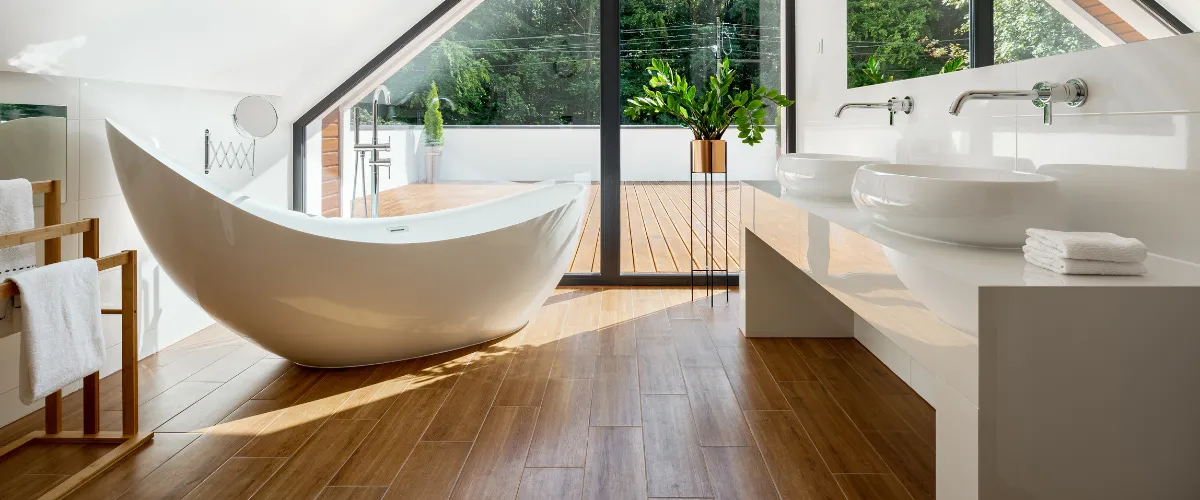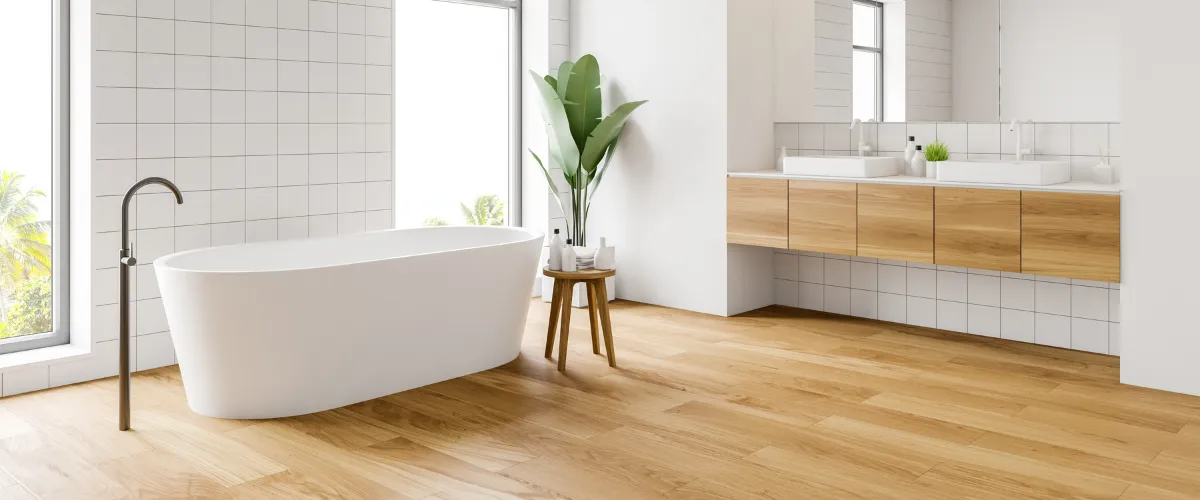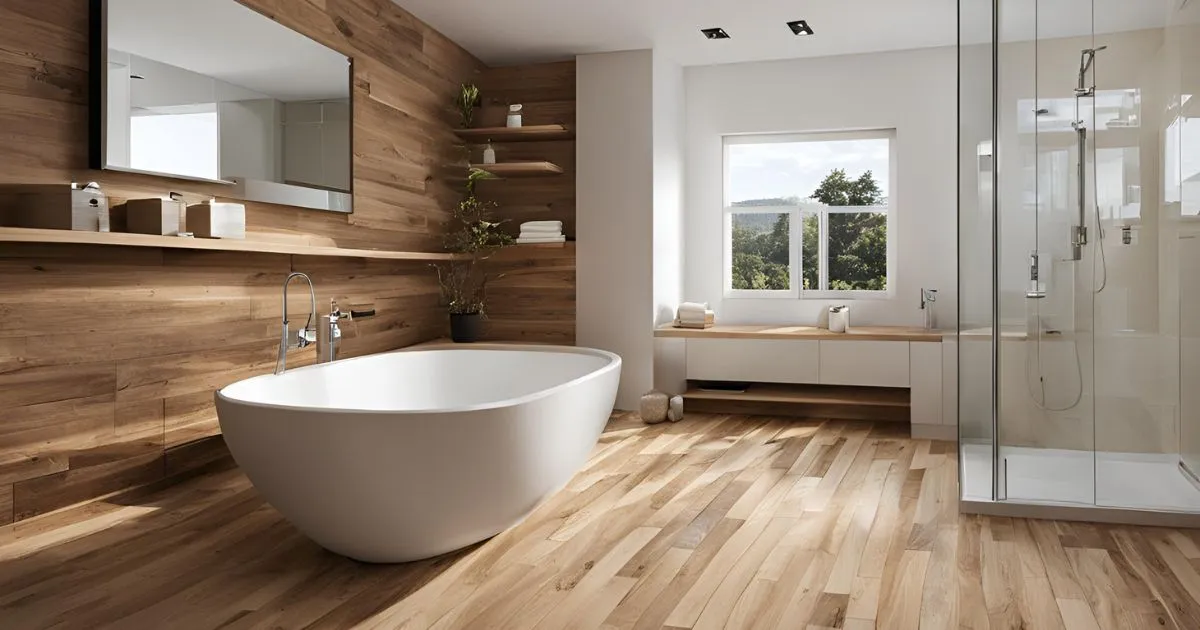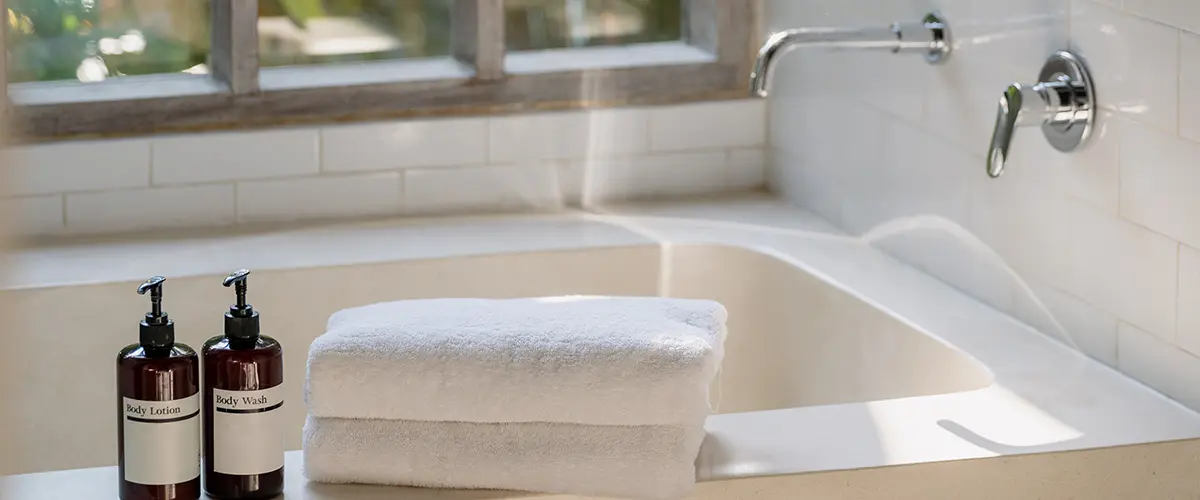Choosing the right flooring for your bathroom can be a tough decision. Wood floors add undeniable warmth and style but come with their own set of challenges, especially in high moisture areas like bathrooms.
This article will explore the pros and cons of installing wood floors in a bathroom, from their elegant appearance to the risks of water damage. Discover if hardwood floors are right for you.

Pros of Having Wood Floors in the Bathroom
Adds elegance and class
Hardwood flooring in the bathroom instantly boosts the room’s elegance and class. This choice brings a warm, inviting atmosphere that tiles can’t match. Homeowners find that wood floors give their powder room or master bath a look of sophistication and luxury.
The natural beauty of oak, maple, or hickory hardwoods adds character and timeless appeal to space.
Using solid hardwood or engineered hardwood in bathrooms transforms them into spa-like retreats. This flooring option seamlessly ties together with other rooms in the house for a cohesive look throughout.
Many homeowners appreciate how wood flooring elevates their home’s overall aesthetic while providing a durable surface underfoot.
Warmer than tiles
Elegance and class from wood floors can extend into a warm welcome in colder months. Wood floors keep bathrooms warmer than ceramic tiles, which often feel cold underfoot especially during winter.
This warmth adds comfort for bare feet and can reduce the need for additional heating in the bathroom, making mornings more pleasant.
Tiles absorb moisture but remain chilly throughout the year. In contrast, wood retains heat better and adjusts to indoor temperatures quicker than porcelain or ceramic materials. So, stepping out of the shower or tub onto a wooden floor makes for a cozier experience compared to stepping on frigid tiles.
Plus, this natural warmth supports an inviting atmosphere in any bathroom space.
Warmer than tiles
Having wood floors in your bathroom means you can create a seamless look throughout your home. Wood brings warmth and a cohesive aesthetic, allowing the beauty of solid hardwood floors to flow from room to room without interruption.
It’s especially appealing for homes where the living area, kitchen, and laundry room share a similar design theme. This unity in flooring strengthens the overall elegance of your house, making spaces appear larger and more inviting.
Choosing wood that complements other areas ensures that all parts of your home reflect a unified style. Whether you opt for oak, maple, or an exotic variety, these floors can be stained to match existing woodwork and cabinetry precisely.
This adaptability makes it easier for homeowners to maintain consistency across different rooms including high moisture environments like bathrooms if properly sealed and maintained.
The Cons of Having a Bathtub
Clutter: When you have a bathtub, it means that you also have more clutter in your bathroom. This is because you will need to store all of your bathing supplies somewhere. If you do not have storage space in your bathroom, this can lead to clutter in other areas of your home as well.
Cleaning: Bathtubs require more cleaning than showers because they have more nooks and crannies for dirt and soap scum to build up. If you do not enjoy cleaning or do not have time for regular cleanings, then having a bathtub might not be ideal for you. Shower door cleaning hacks.
Cost: A freestanding tub can be expensive, both in terms of the initial purchase price and the cost of installation. If you are on a tight budget, this might not be the best option for you. Fortunately, there are many ways to save money on both the purchase and installation of a bathtub so that you can still enjoy all of the benefits without breaking the bank.

Cons of Having Wood Floors in the Bathroom
Susceptible to water damage
More space – Walk-in showers are great for homeowners who want to feel like they have more space in their master bathroom. There’s no need for a shower curtain or shower stall, which means you can make full use of the square footage you have.
Less cleaning – Because there’s no shower door or curtain, there’s also less cleaning involved. You won’t have to worry about soap scum building up, and your shower will stay cleaner overall.
Improved safety – If you have young children or elderly family members living with you, a walk-in shower can be a great way to improve safety. There’s no risk of anyone slipping and falling, and the lack of a door means that you won’t have to worry about anyone getting locked in.
Requires proper waterproofing
Proper waterproofing is essential for wood floors in the bathroom to prevent water damage and maintain their quality over time. This involves applying a water-resistant sealant or finish to create a protective barrier against spills, moisture, and humidity.
By ensuring that the wood flooring is properly maintained with regular sealing and addressing any spills immediately, homeowners can preserve its integrity and enhance its longevity despite being in a high-moisture environment.
In addition to proper waterproofing, consulting flooring professionals for advice on the most suitable wood options can help homeowners make informed decisions based on their bathroom use and maintenance preferences.
Embracing low-maintenance routines such as using bath mats in high traffic areas can further contribute to safeguarding the wood floors from potential water-related issues while adding warmth and character to the bathroom space.
May need periodic refinishing
To maintain wood floors in the bathroom, periodic refinishing may be necessary. This involves sanding down the surface and applying a new finish to restore its luster. On average, wood floors in high-traffic areas like bathrooms should be refinished every 3-5 years to keep them looking their best.
The frequency of refinishing depends on factors such as wear and tear, the type of finish used, and how well the floor is maintained. It’s essential to stay diligent with this upkeep to prolong the lifespan of your bathroom wood flooring.

Tips for Choosing and Maintaining Wood Floors in the Bathroom
Proper waterproofing and sealing
Proper waterproofing and sealing are essential for wood floors in the bathroom. Without it, the wood is vulnerable to water damage, resulting in warping and mold growth. Make sure that the selected sealant is specifically formulated for bathrooms and capable of withstanding moisture.
Regularly examine the floors for any indications of wear or damage to promptly address any issues.
Moreover, the application of multiple coats of a high-quality polyurethane sealant can offer an additional layer of protection against water damage and enhance the wood’s durability.
It is also important to follow the manufacturer’s recommendations for reapplying the sealant to ensure its ongoing effectiveness.
Regular cleaning and maintenance
Regular cleaning and maintenance of wood floors in the bathroom is crucial to preserve their beauty and longevity. To keep them looking their best, sweep or vacuum regularly to remove dust and debris.
Wipe up any water spills promptly to prevent damage from moisture. Use a damp mop with a mild wood floor cleaner for routine cleaning; avoid excessive water that could seep into the seams.
It’s important to remember to consider using rugs or mats in high traffic areas to protect the wood from wear and tear.
For deeper cleaning, consult flooring professionals for suitable wood-friendly products. Regularly check for signs of wear, such as scratches or fading, and address them promptly to maintain the floor’s appeal.
By staying dedicated to upkeep, homeowners can ensure their wood floors remain a stunning addition to their bathroom space while enduring everyday use.
Consider using rug or mat in high traffic areas
To maintain the durability of your wood floors in high traffic areas, consider using rugs or mats. These can help prevent scratches and wear in frequently walked areas. Placing a rug or mat near the sink and shower can also protect your wood floor from water exposure.
Moreover, choosing rugs with slip-resistant backing not only provides safety in the bathroom but also safeguards your elegant wood flooring. Are you prepared to explore tips for choosing and preserving wood floors in the bathroom?

Top Manufacturers of Bathroom Flooring
Susceptible to water damage
Armstrong Flooring
Known for its durable vinyl and laminate options, Armstrong offers a wide variety of stylish designs.
Shaw Floors
A leader in carpet and resilient flooring, Shaw offers a range of beautiful products tailored for high-moisture environments.
Tarkett
Tarkett focuses on innovative, water-resistant options ideal for bathrooms while prioritizing health and environmental sustainability.
Mannington
Mannington offers a diverse selection of luxury vinyl tile and laminate flooring, combining beauty and practicality for bathroom spaces.
Trust Our Experienced Professionals for Your Flooring Needs
With years of dedicated service in the flooring industry, our expert team ensures top-notch results. Choosing the right professionals saves you money in the long run. Do you live in Pennsylvania and are ready to tackle your bathroom remodeling project?
